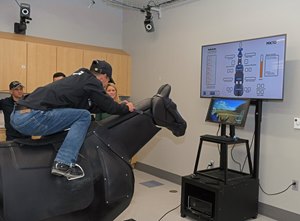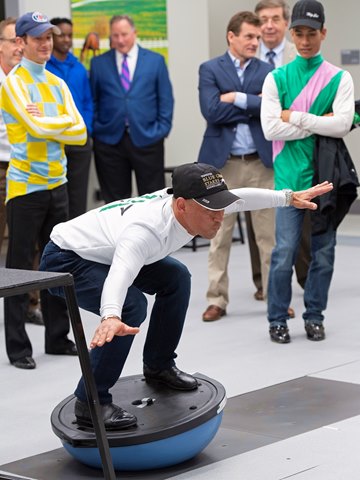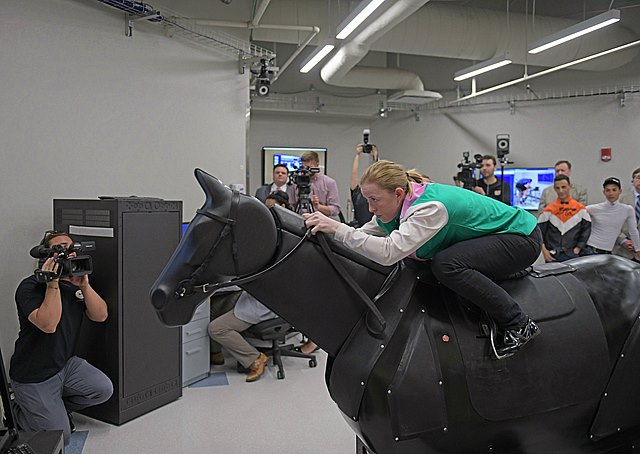KY Sports Medicine Lab Includes Jockey Health Emphasis


Nick Heebner marveled as world-class jockeys stepped onto the Bosu Ball he'd doctored a bit into a balance-measuring instrument. Each rider would lock into a riding stance that left his sensors finding no aberrations to the left, right, forward, or back—displaying this information on an immediately readable graphic as a flat line.
The jockeys, including Hall of Famers Javier Castellano and John Velazquez, were enjoying an April 11 visit to the Jockey and Equestrian Initiative, part of the world-class Sports Medicine Research Institute at the University of Kentucky. Launched last fall, the JEI aims to conduct research on jockey and equestrian riding protection, safety, and performance research.
Heebner, as associate director for research at SMRI, had watched his mechanism—what looks like half a hard-shelled ball cut in half with a flat surface on top and sensors attached throughout—send beginning riders from the North American Racing Academy of the Bluegrass Community and Technical College equine program jostling to find or maintain balance. But Thursday, some top riders from Keeneland kept the Bosu Ball as level as bottoms of their multiple Eclipse Awards on display.

"That was impressive," Heebner said of the test that asks riders to maintain their position for two minutes. It's one of the pieces of technology that mimics real-life situations as the state-of-the-art JEI attempts to gather information that will lead to better understanding of riding injuries as well as better equipment and technique to prevent such setbacks.
JEI director Carl Mattacola, who has worked with the Jockeys' Guild and The Jockey Club, succeeded in his efforts to include the program when UK launched the SMRI under Scott Lephart. Lephart oversaw a similar program at the University of Pittsburgh that once conducted a five-year study to examine why female athletes were tearing their anterior cruciate ligaments at a disproportionate rate compared with males. That study led to programs that mitigated risk of injury and reduced injury rates in female athletes.
The JEI, one of four areas of concentration within SMRI, aims to have similar results for jockeys and other equestrian sports. The SMRI's other areas of research concentration are UK athletics, active duty military personnel and veterans, and women's health initiatives. Lephart said it made sense to include JEI at the Lexington facility on the UK campus.
"Coming to Lexington, we wanted to bring our sports medicine capacity to this industry, the equine industry," Lephart said. "If we can identify risks of injury, mitigate risk of injury, accelerate how we diagnose, treat, and rehabilitate injuries, we think that will have a significant impact on the industry."
SMRI draws on faculty—orthopedic experts, medical experts, and strength and conditioning experts from across the campus.
"We will become, and we're on our way to becoming, a global leader in the area of sports medicine research," Lephart said. "Specifically in musculoskeletal injuries, studying concussions—you'll see demonstrations of all these today—and studying physiology and metabolism, we know that's particularly important to this industry as it relates to weight management and factors that contribute to the way these guys perform.
"What we want to bring to your industry is evidence and science, which there isn't a ton of yet. … In your industry, science and study is lagging behind."
Mattacola said the state-of-the-art equipment and lab will help produce sport-specific research that the JEI will provide to the racing industry and the public.
"Jockeys and equestrians don't have access like other athletes. I've said this for six years to the Jockeys' Guild—many of your children in high school and middle school sports have better access to health care than our professional jockeys do and other equestrians do. There's limited research in this area. There's much more vibrant research in other sports—football, basketball, baseball, to name a few."
Mattacola said research will be the emphasis at JEI.
"We need the data. We need to provide information to the equestrian industry to prevent injury," Mattacola said. "We're committed to outreach—providing more information on concussions, improving wellness and lifelong health of participants but also advancing the workforce and helping the industry, racing and equestrian."
That equipment includes an MK9 mechanical horse from England—or, as Mattacola likes to say, "imported from the U.K. to UK." The mechanical horse is surrounded by cameras that examine a rider's balance, pressure points, and heart rate. By collecting data on top riders, the JEI hopes to provide new information.
Beyond that, riders who may be rehabilitating from injury can use such equipment to chart their progress. Castellano, Eclipse Award winner Jose Ortiz, and graded stakes-winning rider Sophie Doyle could tell they were getting a workout on the mechanical horse. Eclipse Award winner Julien Leparoux tested his balance on the Bosu Ball. Information gathered from studying such top riders will help JEI in its research.

Jockeys' Guild chairman Velazquez couldn't believe what he was seeing at the facility.
"It's incredible. It's nice to see something like this dedicated to research and development and rehabilitation," Velazquez said. "To have a facility like this, we've never seen something like this before."
While in some ways such equipment can be fun, Jockeys' Guild national manager Terry Meyocks said the efforts to improve rider safety and health will benefit the entire industry.
"What's important is that this not only helps jockeys and equestrian, but it helps the racetracks, reduces liabilities, will reduce costs of on-track policies, workers' compensation here in Kentucky, and it could be throughout the world. That reduced cost helps keep people in the business.
"Again, if we can save one life, save one person from being paralyzed, whether it's a jockey or exercise rider, it's worth it."
Video
